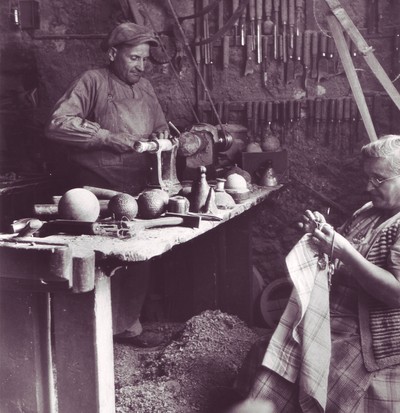Tournage sur bois d’Aiguines, savoir-faire régional
the 28 June 2019
THE WOOD TURNERS OF AIGUINES
Since the dawn of time, man has been in contact with matter. The wood age began in the Neolithic period and started to decline when the first industrial revolutions shook the world. It was initially transformed in order to respond to man’s most basic needs, today wood is essentially exalted by artistic artisans. In both cases, the wooden artefact retains the imprint and the intelligence of the person that has worked it. This surplus of soul and this singularity express the technical progress, whilst symbolising the history of human evolution.
At first, the wood turners of Aiguines only created utilitarian objects in response to a clear demand, and adapted to a specific function. Today, these artisans who possess a secular savoir-faire, have a new vision on matter, a vision that is at the intersection of tradition and innovation. Since the sixteenth century, the small village of Aiguines, located in the Haut Var is the cradle for a unique craftsmanship, which today attracts artisans and designers from the world over. This activity is inextricably linked to the local forest, a resource which the villagers knew how to exploit. During the winter periods, the farmers discovered an alternative activity in the conception of utilitarian objects.
But, the celebrity of this little village, situated on the border of the Var department, is due to the manufacturing of studded boules, ancestors to today’s steel petanque boules. The game of boules was born on the Mediterranean coastline several thousand years ago. At first they were made from stone in ancient Egypt and then out of wood in the Roman era. It was in order to mitigate their unevenness that the villagers of Aiguines had the idea of reinforcing them, at first by partially studding them and then completely. Whilst the men undertook the turning of the wood from the roots of boxwood, the women took charge of the studding in the town square. The boxwood roots — the essence of a wood that is both “easily available and free” because it grows abundantly locally — were dug up by the farmers in zones that were often difficult to access, then dried over many years, before being turned by an artisan. Up until the first quarter of the twentieth century, the act of turning wood was largely manual, however, the electrification of the village also brought about the arrival of electric motors. The studding of the boules is undertaken with small, flat headed tacks in steel, copper, or brass which results in the creation of polychromatic patterns. Hence, it was a matter of personalising a utilitarian object, in a way, to bestow it with the crest of the boules player. The celebrity of these boules travelled beyond the boundaries of the Provençal territory, as they were exported to the four corners of France and its colonies. This painstaking and time consuming work lasted until the end of the 1920s when the last remaining factory was damaged by a disastrous fire. Today, these boules have become collectors items appreciated by amateurs for their beauty. Thus, the everyday object exceeds its initial function and is re-appropriated in order to acquire a new status. Since the 1950s, the growth in tourism has encouraged the wood turners of Aiguines to work autonomously, as independent artisans.
Georges Henri Rivière — the important museologist and friend to Charles and Marie- Laure de Noailles — created in 1977 with Anne Gruner Schlumberger an association which allowed for: “the conservation and valorisation of testimonies on the daily life and culture of the Haut Var.” In 1980, it inaugurated the first Aiguines museum, whose collection is currently deposited at the Musée des Arts et Traditions populaires in Draguignan.
To this day, most of the tools used in the production of these objects are made by hand by the artisans themselves. The precision of these tools combined with the dexterity of the artisans allows them to transform a living, rough material, to manipulate its flaws, and to push back its formal constraints.
Since opening a museum and a training centre for contemporary wood turning in 2012, Aiguines has attracted artisans from around the world who possess vernacular skills. This village in the Haut Var has thus become a centre for emulation that is without precedent, a niche for a community which unites and fosters the emergence of new competences. The artisans of Aiguines, protectors of knowledge and secular practices, strive so that this heritage serves as a source of inspiration for the designers of today. Since, tradition is also evolution, a permanent adaptation of techniques and forms which echo the creations of a period.
Éléa Le Gangneux
Historienne - Université Paris Sorbonne / INHA
